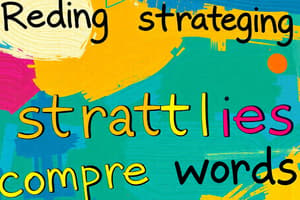Podcast
Questions and Answers
What are the two main reading strategies that are often confused by students?
What are the two main reading strategies that are often confused by students?
Skimming and scanning.
What is the purpose of using graphic organizers and discussion prompts when teaching nonfiction material?
What is the purpose of using graphic organizers and discussion prompts when teaching nonfiction material?
To enhance students' understanding of the content and facilitate deeper engagement with the material.
To cater to different reading levels, it is recommended to create a selection of ______ reading resources.
To cater to different reading levels, it is recommended to create a selection of ______ reading resources.
tiered
What are some examples of targeted fluency activities that can be used to improve students' reading fluency?
What are some examples of targeted fluency activities that can be used to improve students' reading fluency?
What three digital resources or apps can be used to promote reading engagement and comprehension?
What three digital resources or apps can be used to promote reading engagement and comprehension?
What are some strategies that can be used to help English Language Learners (ELLs) improve their reading comprehension?
What are some strategies that can be used to help English Language Learners (ELLs) improve their reading comprehension?
What is the purpose of a workshop that focuses on teaching students skimming for main ideas and scanning for specific details?
What is the purpose of a workshop that focuses on teaching students skimming for main ideas and scanning for specific details?
It is important to encourage students to read every word of a passage in order to ensure thorough comprehension.
It is important to encourage students to read every word of a passage in order to ensure thorough comprehension.
Why are follow-up questions important in reinforcing students' comprehension and application of reading techniques?
Why are follow-up questions important in reinforcing students' comprehension and application of reading techniques?
What are the three stages of teaching reading?
What are the three stages of teaching reading?
Flashcards
Reading as a skill
Reading as a skill
Reading is a complex cognitive process involving decoding, understanding, and interpreting written text.
Skimming
Skimming
Quickly reading a text to get the main idea.
Scanning
Scanning
Quickly looking for specific information in a text.
Reading Comprehension
Reading Comprehension
Signup and view all the flashcards
Nonfiction Texts
Nonfiction Texts
Signup and view all the flashcards
Graphic Organizers
Graphic Organizers
Signup and view all the flashcards
Differentiated Instruction
Differentiated Instruction
Signup and view all the flashcards
Reading Fluency
Reading Fluency
Signup and view all the flashcards
Repeated Reading
Repeated Reading
Signup and view all the flashcards
Paired Reading
Paired Reading
Signup and view all the flashcards
Audiobooks
Audiobooks
Signup and view all the flashcards
ELLs (English Language Learners)
ELLs (English Language Learners)
Signup and view all the flashcards
Bilingual Texts
Bilingual Texts
Signup and view all the flashcards
Scaffolded Reading Strategies
Scaffolded Reading Strategies
Signup and view all the flashcards
Pre-Reading Activities
Pre-Reading Activities
Signup and view all the flashcards
While-Reading Activities
While-Reading Activities
Signup and view all the flashcards
Post-Reading Activities
Post-Reading Activities
Signup and view all the flashcards
Reading Rubrics
Reading Rubrics
Signup and view all the flashcards
Tiered Reading Resources
Tiered Reading Resources
Signup and view all the flashcards
Reading Assessment
Reading Assessment
Signup and view all the flashcards
Study Notes
Home Assignment 8: Teaching Reading
- Theoretical Issues:
- Reading as a skill
- Reading strategies (skimming, scanning)
- Principles of reading
- Criteria for selecting reading materials
- Teaching reading procedure (pre-, while-, post-activities)
- Reading assessment rubrics
Problem-Solving Tasks
-
Task 1:
- Students struggle with nonfiction comprehension.
- Create a plan with strategies and activities (e.g., graphic organizers, discussions) to enhance understanding.
-
Task 2:
- Diverse reading levels (reluctant to advanced).
- Plan tiered reading resources for different levels.
- Implement resources in small group instruction for support.
-
Task 3:
- Students struggled with reading fluency (assessment results).
- Develop fluency activities (repeated reading, paired reading, audiobooks).
- Monitor progress and adjust instruction.
-
Task 4:
- Integrate technology for reading engagement.
- Research and select 3 effective digital resources/apps for reading engagement and understanding.
- Integrate into lessons to enhance learning.
-
Task 5:
- English Language Learners (ELLs) struggle with reading comprehension due to language barriers.
- Develop a differentiated approach using scaffolded strategies (bilingual texts, visual aids).
- Improve comprehension and English proficiency.
-
Task 6:
- Students struggle to differentiate between skimming and scanning.
- Create a lesson plan defining and practicing skimming and scanning techniques.
- Assess student skill application.
-
Task 7:
- Students spend excessive time reading, missing key details.
- Develop a reading workshop focusing on skimming (main idea) and scanning (specific details).
- Enhance speed and accuracy.
-
Task 8:
- Students read every word (slow).
- Design targeted exercises encouraging skimming (understanding) and scanning (specific facts).
- Enhance comprehension and technique application.
Studying That Suits You
Use AI to generate personalized quizzes and flashcards to suit your learning preferences.




